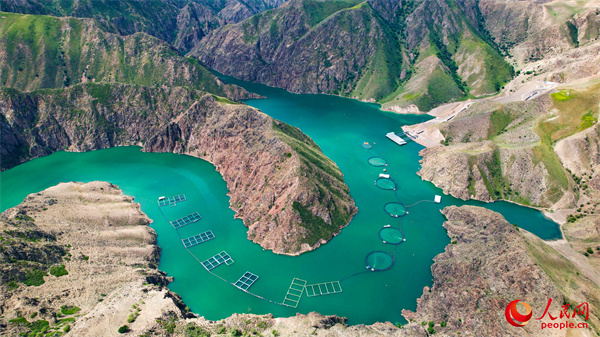Aquaculture thrives in NW China's Xinjiang
The development of natural water fishery resources intensifies each year, leading to a new wave in inland aquaculture. This surge in northwest China’s Xinjiang Uygur Autonomous Region has emerged through advanced breeding techniques, presenting the industry with unprecedented opportunities for growth.
Xinjiang's thriving fishery sector owes its success to government support, and assistance from within and outside the region. In 2023, Xinjiang's online retail sales of aquatic products reached 395 million yuan (about $54.29 million), marking a 106.26 percent increase year-over-year.
In the Gudukou Aquaculture Farmers' Cooperative, located on the edge of the Taklimakan Desert, Xinjiang, workers were harvesting crayfish. Ma Chunhua, head of the cooperative, was busy weighing and loading the catch for customers.

Photo shows the salmon farm of Xinjiang Tianyun Organic Agriculture Co., Ltd. in Karasu township, Nilka county, Ili Kazak Autonomous Prefecture, northwest China's Xinjiang Uygur Autonomous Region. (People's Daily Online/Li Xinyang)
Ma has been farming crayfish on the edge of the desert since 2017. Through experimentation and learning, she has triumphed over the technical hurdles associated with crayfish farming and devised a farming model incorporating crayfish farming and water caltrop cultivation. The crayfish produced under this model are in high demand in the market owing to their exceptional meat quality and impressive size.
"The cooperative now achieves a yield of 150 kilograms of crayfish per mu (one mu is about 0.067 hectares), and the cooperative's membership has grown from the initial four to 10. Each member earns an additional 50,000 yuan annually," said Ma.
Despite being far from the ocean, Xinjiang boasts a water area of 5,500 square kilometers and over 46 million mu of land suitable for aquaculture. Moreover, the region's water bodies are home to more than 500 species of bait organisms, providing ample food resources for the growth of aquatic products.
Recently, 30,000 crab seedlings were airlifted from Sanmen county, Taizhou city, east China's Zhejiang Province, to an aquaculture base in Xinkailing township, Aral city of Xinjiang.
Additionally, 2,000 pearl gentian grouper seedlings were transported from south China's Hainan Province to Longda Aquaculture Farmers' Cooperative in Aral city.
Shu Miaoan, an expert from Zhejiang University's College of Animal Science, said that the successful introduction of pearl gentian grouper seedlings not only enriches the aquaculture species in Aral city and improves the efficiency of aquaculture but also provides new ideas and approaches for utilizing saline-alkali land.
"Longda Aquaculture Farmers' Cooperative and Zhejiang University's Rural Development Academy have jointly established a cooperation demonstration base to promote the cultivation of high-end seafood in Xinjiang," said Shu.
According to Shu, the 2,000 pearl gentian grouper seedlings released this time are in good condition. He also disclosed the upcoming release of an additional 12,000 seedlings, which are projected to yield 6.2 tonnes of mature pearl gentian groupers. At a price of 150 yuan per kilogram, the estimated production value is expected to surpass 900,000 yuan.
In a salmon cultivation base situated in Kalasu township, Nilka county, located in northern Xinjiang, freshly caught salmon undergoes swift processing, packaging, and transportation, reaching consumers' tables within a mere 24 hours. The base has the capability to process up to 50 tonnes of salmon daily.
Industry experts have pointed out that the utilization of saline-alkali land for aquaculture and agriculture will be a major highlight in the development of fisheries in Xinjiang.
Shi Xuecan, head of Tianquan Xueyuan Aquaculture Farmers' Cooperative in Xinjiang's Aksu Prefecture, said this year his cooperative invested 8 million yuan to further expand its operations in response to the increasing demand for cold-water fish.
Following the expansion, the cooperative will shift its focus to salmon farming. With an anticipated annual production of 600 tonnes of salmon, the cooperative aims to generate an output value of around 30 million yuan.
Xinjiang has been continuously making strides in fish species introduction, breeding, and cultivation. Currently, over 100 fish species, mostly introduced from other regions, are being cultivated throughout Xinjiang.
Through these concerted efforts, Xinjiang's aquaculture sector is demonstrating how science, policy support, and creative adaptation can transform challenging environments into thriving centers of aquatic production, fostering economic growth and environmental sustainability.
Photos
Related Stories
- Xinjiang's foreign trade up 48.4 pct in H1
- Nalati grassland showdown: Boy races horse with car
- Dulata port in NW China's Xinjiang witnesses cross-border travel boom
- Lavender industry booms in slow-paced Xinjiang village
- China schedules over 150 special tourist trains to Xinjiang
- In pics: 12th National Traditional Games of Ethnic Minorities of China
- Major wheat production area in China's Xinjiang greets harvest season
- Equestrian events of China's 12th Ethnic Games begin
- Xinjiang scientists discover plant with potential to survive on Mars
- Wondrous Xinjiang: A tale of two names -- Pairing assistance helps Xinjiang village chart prosperous path
Copyright © 2024 People's Daily Online. All Rights Reserved.









